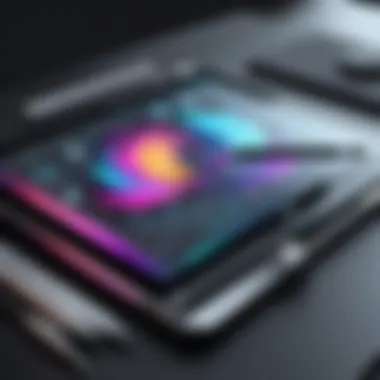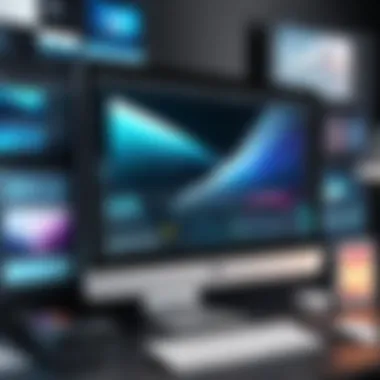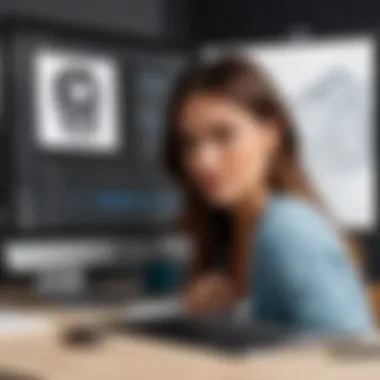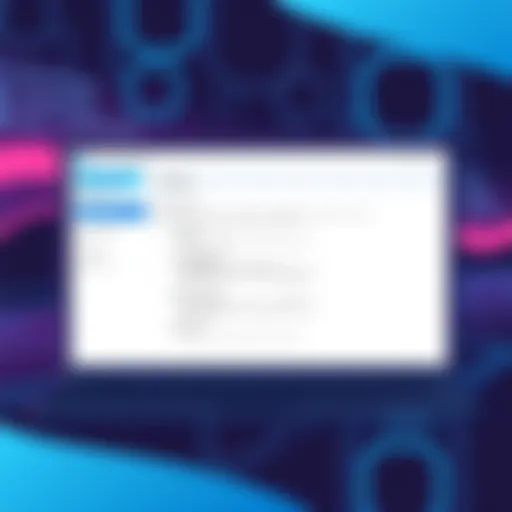Finding the Ideal Digital Drawing App for You


Intro
In today's digital-first world, the art landscape has shifted dramatically. The tools artists and hobbyists once relied on—pencils, paints, and canvases—are now complemented, if not replaced, by sophisticated digital drawing applications. With options that range from beginner-friendly interfaces to professional-grade software, the challenge lies in navigating this plethora of choices to find the right app that aligns with one’s artistic goals and workflow.
Consider this: You’re an aspiring artist ready to take your skills to the next level. You want more than just basic tools; you crave versatility, precision, and features that explode the potential of your creativity. On the flip side, maybe you're a casual doodler who simply wants a straightforward platform to sketch your ideas without any fuss. In either case, knowing what to look for in a digital drawing application can make all the difference.
As we delve into the complex world of drawing applications, we’ll unpack various aspects that lend insight into each platform's capabilities, usability, and overall value. From the capabilities that each app brings to the table to hardware requirements, pricing, and artistic avenues, we aim to offer a road map for making an educated decision in a diverse market.
The objective is not merely to review apps—it's about empowering you with knowledge that enhances your digital art journey. The choices are vast, but with the right guidance, anyone can find an application tailored to their unique expressive needs.
Prologue to Digital Art
Digital art has emerged as a major branch of the artistic spectrum in the last few decades. As technology has advanced, the tools available for creators have developed in tandem, enabling artists to explore new horizons. Whether you're a seasoned professional or just dipping your toes into the digital waters, understanding how digital art has evolved can provide crucial insight into your creative process.
Today’s drawing applications offer not just a replicate of traditional tools, but also new functionalities that empower artists. Digital artwork allows for various styles, textures, and techniques that aren't easily achievable with paint and canvas. Moreover, the immediacy of digital art—changes can be made with a few clicks—has changed the way art is conceived and produced.
It’s not just about painting or sketching anymore; the scope includes animation, graphic design, and even mixed media art. Evaluating these changes paves a smoother path for artists to choose the right software that aligns with their specific artistic aspirations.
The Evolution of Art in the Digital Realm
The journey of digital art began as early as the 1950s, but it didn’t truly take off until the advent of personal computing. Artists started experimenting with simple graphics software, transitioning from physical media to digital formats. Over the years, this shift gained momentum, leading to sophisticated programs that replicate not only the appearance but also the functionality of traditional tools.
Platforms like Adobe Photoshop revolutionized the way art is created. Offering layers, brushes, and an array of editing capabilities, artists found themselves with a palette as diverse as the creative mind could envision.
Traditional methods require hours of planning and changes can be labor-intensive. Digital artist can simply undo mistakes or alter elements without starting from scratch. This technological leap has democratized art creation; it’s no longer confined to professionals but has opened up an entire playground for amateurs and hobbyists alike.
The Role of Software in Modern Art Creation
The software tools available today are the backbone of digital art. They dictate not just the medium but also the style and the method of creation. Affordable drawing apps can empower emerging artists, while advanced options cater to professionals seeking more complexity in their work.
Key features in contemporary software include:
- Customizable Brushes: Mimicking every conceivable traditional tool, artists can create unique brushes tailored to their specific needs.
- Layer Management: This allows for intricate designs without clutter.
- Real-time Feedback: Artists see effects and changes immediately.
As the landscape of digital art continues to grow, the need for a solid understanding of the software choices available becomes critical. Choosing the right app can heavily influence an artist’s workflow and the overall outcome of their artwork.
"Digital art is like a blank canvas that transforms with each click; the only limit is your imagination."
This article aims to aid readers in selecting the optimal drawing application that suits their needs, exploring the vibrant options that provide a gateway to creativity.
Criteria for Selecting a Drawing App
When it comes to diving into the world of digital drawing, the choices can be as abundant as a summer rain. Understanding the criteria for selecting a drawing app is crucial because it helps you hone in on what matters most for your individual needs. Each creative journey is unique, so remember, the right app can make all the difference in how smoothly you can express your artistic vision.
User Interface and Experience
The user interface (UI) shapes your first impressions of an app; it's like the face of a book that draws you in. An intuitive UI can ease the learning curve significantly, allowing you to focus on your art instead of wrestling with complex controls. Look for an app that boasts clear menus and customizable layouts. If you can personalize your workspace to your liking, you're more likely to maintain a flow in your creativity.
Moreover, consider how the app responds to your actions. A well-optimized experience will be fluid and responsive, giving you that satisfying feedback as you draw. A poor interface can easily lead to frustration, especially when you have to hunt for tools during your creative process. The goal is to create a seamless relationship between your skills and the digital canvas.
Tools and Features
Next up, we cannot overlook the tools and features your chosen app should provide. Look for a diverse array of brushes, pens, colors, and textures that can mimic real-life media. Features like layer support, blending modes, and customizable shortcuts are essential for breathing life into your artwork. Ideally, the app should allow you to easily switch between different styles and techniques, almost like flipping a switch.
For instance, if you’re keen on graphic novels, an application with strong comic creation tools and typography options can make all the difference. On the other hand, if you prefer deep painting techniques, then look out for tools that support natural media brushes. This variety enhances your creative toolbox, giving you the flexibility to explore and refine your artistic voice.
Compatibility with Operating Systems
Compatibility is another crucial factor to consider. Your ideal app should run smoothly on your operating system, be it Windows, macOS, or Linux. It’s disappointing to fall in love with an application only to discover it's not available for your platform.
But it doesn't stop there—consider also whether the app supports various device forms. Some apps work seamlessly across tablets and desktops, enabling you to transfer projects without a hitch. This flexibility allows you the freedom to create art wherever inspiration strikes.
Performance and Stability
Performance is the backbone of any app. You want an experience that runs without hiccups, especially when your creativity is flowing like a river. A stable application can handle complex projects with large files, so you won't find yourself staring at a spinning wheel of doom.
A good drawing app should support high-resolution canvases and allow for multiple layers with minimal lagging. Check reviews and forums to gauge how the app performs in real-world scenarios. Some may boast of features, but if it crashes often, that’s a hard pass.


Community and Support Resources
Lastly, consider the community and support resources available for your chosen app. Having a robust community can enhance your learning curve and offer a wealth of resources—from tutorials to online forums where you can share tips and tricks.
Solid customer support is just as important. When you encounter a snag, you want to know that help is readily available. Whether it’s a troubleshooting guide on the official website or active community members ready to lend a hand, robust support can elevate your overall experience.
Top Drawing Apps Reviewed
Choosing the right drawing app is akin to selecting the right brush for a canvas; the tools you use can either enhance your creativity or hamper it. Each application has its own distinct flavor, catering to different artistic styles and technical needs. As we delve into the variety of products that are available, it’s essential to consider the core features, strengths, weaknesses, and best use cases of each option. This section aims to highlight the leading apps that are making waves in the digital art community and provide insight into what makes them tick.
Adobe Photoshop
Features Overview
Adobe Photoshop is a titan in the realm of digital art. Its robust features range from advanced photo editing to superb painting tools. One of its standout capabilities is the extensive brush engine that allows for significant customization, offering artists the ability to create unique visual effects. This flexibility makes it a darling among professionals who appreciate both its painting and photo manipulation functionalities.
However, the complexity of features can be overwhelming for beginners. Despite this steep learning curve, those who invest the time often find that its versatility is well worth the effort.
Strengths and Weaknesses
One of the main strengths of Adobe Photoshop lies in its extensive toolkit. From blending modes to layer styles, it offers almost limitless possibilities for creation. Yet this very reason also highlights a significant weakness; for newcomers, navigating through myriad functionalities can feel like trying to find a needle in a haystack. The subscription-based model also raises eyebrows, making it a costly option for those who want to dabble rather than commit.
Best Use Cases
Photoshop shines in industries where quality matters, such as graphic design and digital painting. It’s particularly favored by illustrators who require precision and an array of drawing techniques. The unique feature of intelligent object selection enhances productivity by allowing users to focus on their artwork rather than tedious adjustments.
Corel Painter
Features Overview
Corel Painter is frequently hailed as a favorite among traditional artists making the leap to digital. Its brush varieties mimic real-world materials, such as oil paints and chalk, offering authenticity that many other applications lack. This feature transforms the screen into a vibrant canvas full of textures and styles, appealing to those who wish to retain a natural feel in their digital work.
However, this authenticity comes with diminished performance on lower-end systems. It’s best experienced on robust hardware, which can be a barrier for some artists.
Strengths and Weaknesses
The strength of Corel Painter is undoubtedly its ability to replicate traditional art styles closely. Artists familiar with oil or watercolor will feel right at home. On the flip side, its interface can be a bit clunky and less intuitive compared to competitors, which might deter new users from exploring the full range of possibilities.
Best Use Cases
This app is perfect for artists aiming to create fine art or intricate illustrations. If you’re looking to replicate the feel of painting with physical mediums without the mess, Corel Painter lets you immerse yourself into a natural workflow that many find enriching.
Clip Studio Paint
Features Overview
Clip Studio Paint is designed primarily for illustrators and comic artists, making it a go-to application for manga creators. Its features are optimized for line art and coloring, and its vector layers are a game-changer for those who work with a lot of detail. Users can easily manipulate lines, providing them flexibility in how their artwork evolves.
A unique advantage of Clip Studio Paint is the 3D models that artists can integrate into their work to assist with drawing poses and perspectives.
Strengths and Weaknesses
The strength of this software is its precision and tools catered specifically to comic artists. However, its weakness includes a somewhat steep pricing model for the full version, which may push casual users to seek cheaper alternatives.
Best Use Cases
Clip Studio Paint is ideal for artists who specialize in manga and graphic novels due to its tailored features. Coupled with customizable shortcuts, it enables efficient workflows for those long hours spent bringing stories to life.
Krita
Features Overview
Krita is well-respected in the digital art community, especially among independent artists. What sets it apart is its open-source nature, and it comes without a price tag, which is a huge draw for many. With built-in brush engines and textures, it allows for diverse styles of painting.
However, Krita’s reliance on community support can sometimes lead to variability in updates and stability, which can be a concern for serious practitioners.
Strengths and Weaknesses


The strength of Krita is fundamentally its zero cost combined with powerful features, making it a quintessential tool for budding artists. Yet, it sometimes struggles with performance lag on larger projects due to its focus on being a versatile, free solution.
Best Use Cases
Krita caters to digital painters who want a robust program without the financial burden. It’s especially great for concept artists and storyboard illustrators who need the flexibility to create across different styles.
Procreate (for iPad)
Features Overview
Procreate takes full advantage of the iPad's capabilities. Its interface is remarkably user-friendly, encouraging creativity with minimal distractions. With hundreds of brushes available and seamless integration of layers, artists can let their imaginations run wild. It also boasts a remarkable feature set for animations, appealing to a rapidly growing sector of digital art.
However, the app is restricted to iOS devices, which limits its user base somewhat.
Strengths and Weaknesses
The strength of Procreate lies in its touch responsiveness and intuitive controls, making it incredibly accessible. However, those who prefer larger screens or workstations may find the smaller iPad interface a little cramped.
Best Use Cases
Procreate is perfect for artists who enjoy sketching on the go or those who prefer a more intimate, tactile approach to drawing. It’s also a favorite among animators for quick and spontaneous projects.
Autodesk SketchBook
Features Overview
Autodesk SketchBook is celebrated for its simplicity and efficiency. Its clean interface focuses heavily on the drawing process rather than unnecessary tools. SketchBook’s various brushes and user-friendly guides make it a great choice for beginners who wish to develop their skills without feeling overwhelmed.
Yet, while its straightforwardness is advantageous for new users, some might find it lacking in professional-grade features that advanced artists often seek.
Strengths and Weaknesses
The main strength is the lightweight nature of this app, which allows for quick access and easy navigation. However, it might not meet the demands of everyone, especially users seeking intricate layering and detailed editing capabilities.
Best Use Cases
SketchBook is best for beginners or hobbyists who are exploring digital drawing. It helps users concentrate on honing their skills without the intimidation of a complex interface.
Affinity Designer
Features Overview
Affinity Designer marries vector and raster graphics, making it a favorite among illustrators who work interchangeably between the two. Its precise control over shapes and colors is complemented by real-time effects that provide immediate feedback on changes. This capability is particularly helpful in crafting detailed, professional work.
Yet, the learning curve can be a bit sharp for those not accustomed to design software, which might slow down initial exploration.
Strengths and Weaknesses
One strength is its professional-grade features available at a competitive price. Its weaknesses include needing a bit of time to get accustomed to the vector editing capabilities, which can overwhelm those who are used to solely raster-based applications.
Best Use Cases
Affinity Designer is ideal for graphic designers and illustrators who require both vector and pixel-based designs in their workflow. It is especially useful for creating logos, branding materials, and intricate illustrations.
Technical Considerations for Drawing Apps
When it comes to selecting a drawing app, technical considerations play a pivotal role that goes beyond mere aesthetic appeal or user reviews. Understanding the technical landscape ensures that your creative endeavors aren't hindered by dissolved compatibility issues or performance glitches. For digital artists, these parameters define the functionality of creativity itself. In the following subsections, we will investigate the hardware requirements, the compatibility of drawing tablets, and the various file formats and export options that can influence the day-to-day use of your digital drawing applications.
Hardware Requirements
Every creative software has its own set of demands on your machine's hardware. Artists often ask, "How much power do I need?" Quite a bit, actually. As apps evolve to include more sophisticated tools and features, the hardware specifications also upgrade.
Here’s a breakdown of key elements to consider:
- Processor: Look for a multi-core processor; dual-core might have trouble keeping up with heavy tasks. Modern drawing apps can be processor-intensive, especially when rendering large files or running in tandem with other software.
- RAM: A minimum of 8 GB is generally recommended. More is better, particularly when working on intricate projects with numerous layers and high resolutions.
- Graphics Card: An excellent GPU can make all the difference. It not only speeds up your rendering but also supports features like real-time brushes and effects in some applications.
The right hardware can boost your creativity because it minimizes lag and delays.


Having a strong foundation in terms of hardware ensures the software runs smoothly, allowing artists to engage in their work without frustration.
Drawing Tablets and Compatibility
If you are eyeing the digital art world, a drawing tablet is practically a game changer. Drawing tablets can range from entry-level models to professional, high-end devices with screens. When selecting a drawing app, you must consider whether it plays nice with your hardware.
Some vital compatibility considerations include:
- Brand Compatibility: Some drawing apps work better with specific brands like Wacom or Huion. Look out for apps that claim seamless functionality with your tablet.
- Drivers and Updates: Ensure the app supports the latest drivers from your tablet's manufacturer. Outdated drivers can cause frustrating issues like input lag or pressure sensitivity problems.
- Gesture Support: Some apps offer improved workflow with gesture support. This can be a significant convenience for artists who value efficiency.
Choosing an app that meshes well with your tablet ensures a smooth user experience. Your stylus should be a seamless extension of your hand, not a tool that complicates your creativity.
File Formats and Export Options
The ability to export and save your artwork in various formats cannot be overstated. Different projects might require different types of files—be it layered files for future edits or standard formats for sharing. Knowing what formats an app supports is crucial.
Consider the following points:
- Common Formats: Look for apps that can seamlessly save as PSD, PNG, JPEG, or TIFF. This variety gives you flexibility in choosing the right format for your needs.
- Layering Options: If you intend to edit your pieces later, you’ll want support for layered file formats. PSDs are popular here, as they preserve layers for future manipulation.
- Export Functionality: Ensure that the app you are leaning towards has robust export functions. This includes batch export options, which are invaluable for artists working on multiple projects.
All these criteria will influence how easy it is to share your work and the quality of the output. The wrong format might mean hours salvaging an artwork or compromises in quality. Evaluating these technical aspects is vital to ensure you choose the right app that fits your creative style and requirements.
Pricing and Subscription Models
When it comes to choosing an app for digital drawing, pricing and subscription models can make a significant difference. They don’t just determine the upfront costs but can impact ongoing expenses and accessibility to features that users might need down the road. Understanding the different pricing structures is essential, as this directly influences not just the tools available, but also the artist’s overall experience.
There are primary elements to consider when evaluating how effectively an app fits into your budget, including whether the app requires a one-time purchase or offers a subscription model, as well as the availability of free and open-source options for those who may be hesitant to invest right off the bat.
One-Time Purchase vs. Subscription
The conversation around one-time purchase versus subscription often stirs passion among digital artists. A one-time purchase may come with a higher initial cost, but it generally provides access to the software indefinitely. This can be quite appealing for those who prefer to pay once and forget about it. However, it also means that users may miss out on new features or updates unless they pay for major upgrades later.
On the flip side, subscription models usually offer a lower initial cost, allowing users to access a rich library of features and regular updates. It’s a bit like renting a place versus owning a home; renting gives you flexibility, but owning can mean stability and a long-term relationship with the tool. Monthly or yearly fees can add up over time, so discerning users should calculate the total cost of ownership over multiple years.
Here are some insights to consider:
- Flexibility of Use: Subscriptions often provide a range of tools for different creative needs, while a one-time purchase may be limited in functionality.
- Budget Management: Subscriptions can help in spreading out expenses, making it easier for new artists to start without a huge financial commitment.
- Access to New Features: With subscriptions, artists often receive updates and new features first, staying ahead in a fast-evolving digital art landscape.
As a user, you’ll have to weigh your options depending on your working style, project needs, and financial situation.
"The choice between subscription or one-time purchase is no simple matter; it can define how you interact with the software and your creative workflow."
Free and Open-Source Options
For those who wish to explore without making a financial commitment, free and open-source options present an excellent alternative. These applications often provide a surprising array of features, especially for beginners or those dabbling in digital art as a hobby.
Using open-source software not only allows artists to scratch their creative itch without breaking the bank, but also fosters a community where users can share insights, troubleshoot together, and even contribute to the software’s development. Here are a few notable considerations:
- Learning and Experimentation: Free software enables experimentation with various styles and techniques without the pressure of making a financial sacrifice.
- Community Support: Most open-source tools come with strong community backing, including forums and tutorials that can help newcomers on their journey.
- Flexibility and Customization: Since it’s open source, users can modify the software to fit unique needs, offering a personal touch to their artistic endeavors.
While free options might not always match the professional stature of paid counterparts, they can still serve as a robust starting point. Don’t hesitate to explore different tools available for free, as they can lead to unexpected creative breakthroughs without any monetary investment.
Epilogue
In an era where digital art is becoming increasingly relevant, effectively choosing a drawing app for your computer can steer your artistic journey in the right direction. The plethora of options available can be bewildering, but this article has provided a roadmap to navigate through these choices. The significance of understanding your needs—be it casual doodling or more elaborate artwork—cannot be overstated. Tailoring your choice to your skill level, workflow prefereneces, and specific requirements is key to unlocking the potential of digital drawing.
Summarizing the Best Choices
To distill the essence of what each app offers, consider the following highlights:
- Adobe Photoshop is a heavyweight, ideal for detailed work and advanced techniques, though it comes at a premium.
- Corel Painter caters to those seeking a natural painting experience, with numerous brushes and textures.
- Clip Studio Paint excels in comic and manga creation, thanks to its versatile tools and features.
- Krita stands out as a free option that does not skimp on quality, making it a favorite among emerging artists.
- Procreate, although designed for iPad, has set benchmarks for ease of use in digital painting and illustration.
- Autodesk SketchBook balances simplicity and functionality, perfect for quick sketches.
- Affinity Designer is a solid choice for vector graphics, offering tools that rival more established software.
Choosing the right app can mean the difference between frustration and inspiration. Factors to balance include your artistic style, whether you lean towards illustrations or paintings, what tools you often require, and the type of device you work on—each plays a role in finding the perfect fit. The apps discussed cater to various needs and preferences, ensuring that there is something for everyone.
Final Thoughts on Selecting the Right App
Ultimately, there’s no one-size-fits-all answer when it comes to selecting a digital drawing application. Just like each artist has their unique style, each app has its own strengths and nuances that will appeal to different individuals. Some may find that they prefer a more comprehensive suite like Adobe Photoshop, while others may lean towards a minimalist approach with something like Sketchbook.
Taking some time to test out different applications can offer practical insights that a review can’t fully capture. Many apps offer free trials or versions; these can be invaluable in determining what feels most intuitive to you.
Also, consider your long-term artistic plans; if you see yourself expanding your skills significantly, picking an app that allows room for growth can be worthwhile.
Remember, the best tool is one that enhances your creativity and fits seamlessly into your workflow. The digital realm is ripe for artistic exploration, so arm yourself with the right platform and let your imagination fly.



